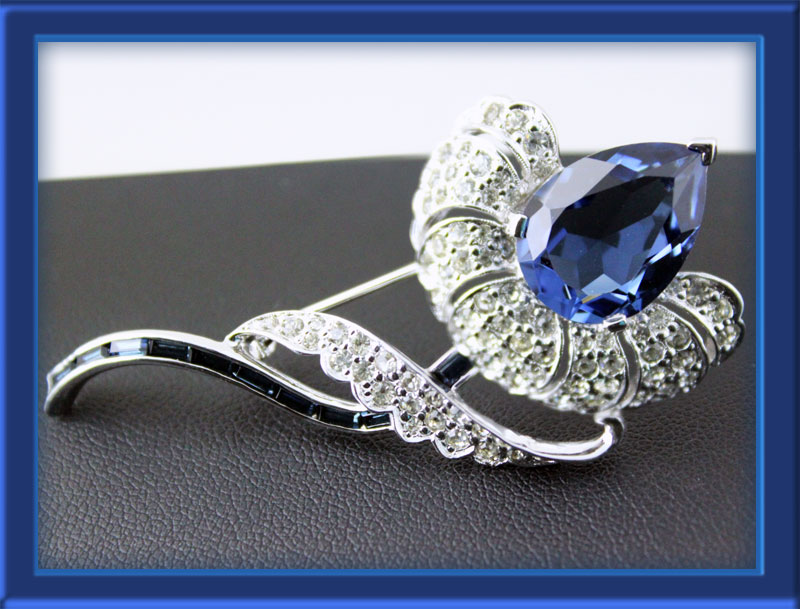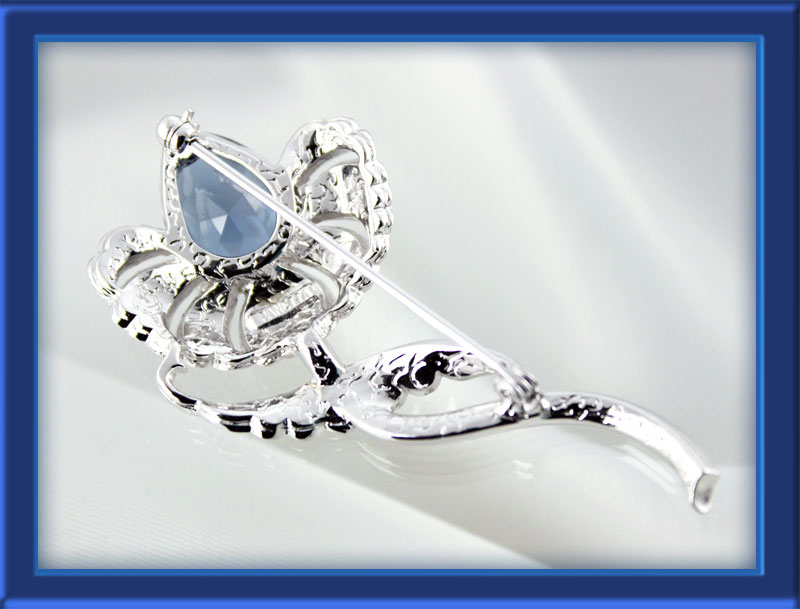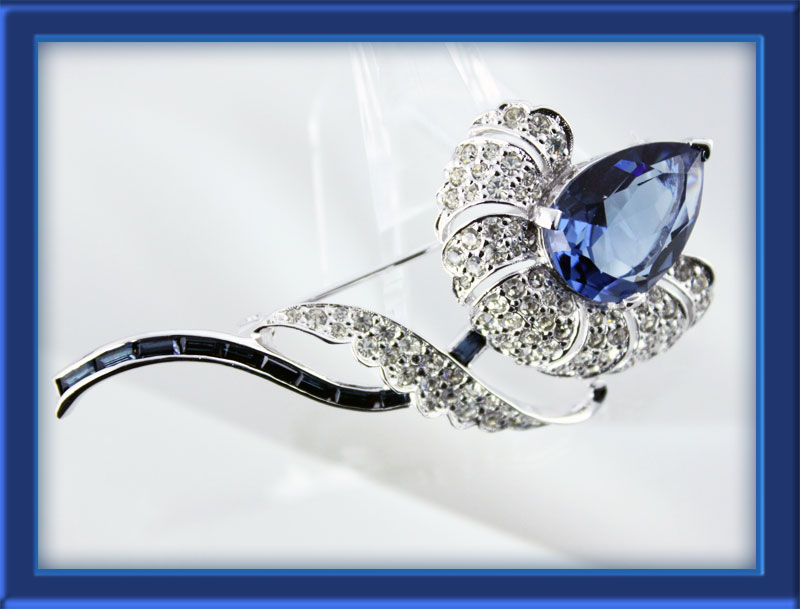Return To Previous Page
Panetta | Pavé jeweled brooch with sapphire glass bud.
Panetta | Pavé jeweled brooch with sapphire glass bud.
. . . . Exquisite!
Panetta
Our elegant brooch & earrings are truly striking and a wonderful example of Panetta's design quality. The rhodium finish is in lovely shape and the main bud shaped open backed rhinestone sparkles like a real sapphire. It just looks rich! The pavé design and faux sapphire bud of this jeweled flower are really a thing of beauty, making this delicate and tasteful design suitable for any occasion.
I would like to point out one thing about any paste costume jewelry that is 50 plus years old. If you have not purchased paste vintage jewelry before I advise that you check the stones from time to time to make sure they are all secure. I think it is too much to expect from any glue to hold every piece in place for 50 to 60 years. So checking to make sure that the rhinestones are secure in these well preserved beauties is a good practice to get into. ID-
Measurements:
Brooch — Approximately 2 ¼ inches in length.Panetta Jewelry History —
Benedetto Panetta (1883? – 1969?) Born in Naples, Italy, Benedetto Panetta had already operated a small jewelry shop there and acquired the skills to create fine platinum jewelry that achieved some success. However, family and financial issues forced him to move to America in 1901.
It didn’t take him long to find work as a platinum jeweler in New York City’s jewelry center. He first became a designer and model maker for Trifari, one of the first American companies to manufacture costume jewelry. He worked there for many years.
In the 1930s, when Trifari moved its headquarters from New York to Providence, Rhode Island, Panetta did not want to uproot his family and took his skills to Pennino Brothers another highly regarded jewelry manufacturer. He worked there for almost another decade.
In 1945, Panetta established his own company with his sons, Amadeo and Armand. They were born in New York and as they grew became part of the Panetta family tradition working with jewelry. Panetta produced costume jewelry with superb designs often carved into metal with heavy sterling silver, silver plating, gold plating, and white metal backings. The jewelry was prong-set, hand-set, unfoiled, and contained beautiful details. Pieces and decoration ranged from high quality rhinestones, simulated stones and pearls encrusted in Art Deco styles to enamel figural designs.
Panetta’s background in fine jewelry was apparent in the pieces he produced. Many were rhodium or gold plated and often resembled the original designs that inspired them. His signature designs include pave set enamel jewelry, high quality rhinestones and elaborate settings. Among the company’s operating principles was that if, the jewelry “didn’t look real, it went back to the drawing board.”
The company did everything to create very exact replicas of the best fine jewelry. Though never cheap even when the pieces first appeared on the market, Panetta’s creations attracted buyers who could easily have afforded the more expensive pieces. The appeal of Panetta’s creations were, in fact, that the pieces were nearly exact replicas of the genuine articles and, while often mistaken for ‘the real thing,’ gave the owners a sense of security if, on the off chance, they were lost or stolen.
Panetta employed his skills working with platinum and used them in white metal to form his jewelry’s base metalwork that produced incredibly realistic effects. The company created a wide assortment of styles including figural pins and accessories for their most sought-after rhinestone pieces mostly produced during the Art Deco period.
Panetta also used a gilt metal that looked like gold as a base for black enamel and rhinestones. Some ring shapes were geometric while other designs resembled snakes with glowing, fake-emerald eyes. Still others were crafted with parallel bands of platinum-colored metal, within which the designer placed oval cups each holding a trio of faux amethysts.
Panetta also made copies of jewelry produced by famous designers like Cartier, Tiffany, Van Cleef and Arpel, and David Webb. With each piece handmade and the imitation stones hand set (no glue or paste), and a Hamilton finish, Panetta jewelry became travel jewelry for the very wealthy. The pieces looked so real that women left their fine jewelry at home to foil thefts.
Benedetto Panetta died in the late 1960s. His sons continued the Panetta tradition into early 1990s when the brothers sold the company to one of their best Japanese customers who closed the business in 1995.
We Buy Gold and Silver: Artists, Costume Jewelry— Benedetto Panetta: [http://webuygoldandsilver.com/benedetto-panetta/]: [2019]
Having trouble with the small sizes of
yesteryear? Well, most of us do!
The ladies were smaller than the women of today.
NO Problem, be sure to check out our necklace extenders.
The ladies were smaller than the women of today.
NO Problem, be sure to check out our necklace extenders.




